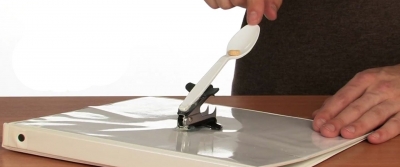
What you need:
A staple remover (the clawed kind) A sturdy file or folder
Sticky tape
Scissors
A plastic spoon
A small ball of foil
What to do:
1. Stick the staple remover (the broader side) to the top of the folder using glue or sticky tape. The staple remover should be firm and steady once stuck
2. Next place the stem of the spoon against the top of the staple remover and tape it. The spoon should rest steadily against the length of the staple remover and its end should line up with the end of the staple removers top.
3. Place the roll of foil in the spoon.
4. Gently pull the head of the spoon down and let go.
What happens:
The ball of foil flies off the catapult you made.
Why?
The catapult is a combination of several simple things. First comes the lever, which is the simplest form of a machine. A lever is a bar resting on a support. One end of the lever usually holds the load while the other end is used to apply pressure to move that load. The support on which the lever rests is known as the fulcrum. It is the fulcrum which makes it easy to transfer force from one end of the lever to another which allows the load to
In our case, there are two levers held together by a spring. The first lever is the staple remover its fulcrum is the end that is opposite the claws where the joint is.
The second lever is the spoon. Its fulcrum is the part that is stuck to the staple remover.
Both these levers are joined by a spring that’s inside the staple remover. This spring is what allows the spoon to snap back up when released and throw the ball of foil.
You can place a book inside the folder which forms the base. This will allow you to change the angle of the catapult. You can find out how that affects your throw.
Picture Credit : Google




